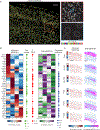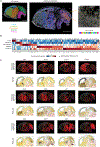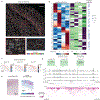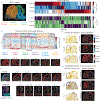Spatially resolved epigenomic profiling of single cells in complex tissues
- PMID: 36272405
- PMCID: PMC9691621
- DOI: 10.1016/j.cell.2022.09.035
Spatially resolved epigenomic profiling of single cells in complex tissues
Erratum in
-
Spatially resolved epigenomic profiling of single cells in complex tissues.Cell. 2023 May 11;186(10):2275-2279. doi: 10.1016/j.cell.2023.04.006. Cell. 2023. PMID: 37172568 Free PMC article.
Abstract
The recent development of spatial omics methods has enabled single-cell profiling of the transcriptome and 3D genome organization with high spatial resolution. Expanding the repertoire of spatial omics tools, a spatially resolved single-cell epigenomics method will accelerate understanding of the spatial regulation of cell and tissue functions. Here, we report a method for spatially resolved epigenomic profiling of single cells using in situ tagmentation and transcription followed by multiplexed imaging. We demonstrated the ability to profile histone modifications marking active promoters, putative enhancers, and silent promoters in individual cells, and generated high-resolution spatial atlas of hundreds of active promoters and putative enhancers in embryonic and adult mouse brains. Our results suggested putative promoter-enhancer pairs and enhancer hubs regulating developmentally important genes. We envision this approach will be generally applicable to spatial profiling of epigenetic modifications and DNA-binding proteins, advancing our understanding of how gene expression is spatiotemporally regulated by the epigenome.
Keywords: MERFISH; brain; development; enhancer; enhancer hub; enhancer-promoter interaction; epigenomic MERFISH; promoter; single-cell epigenomics; spatial epigenomic.
Copyright © 2022 The Authors. Published by Elsevier Inc. All rights reserved.
Conflict of interest statement
Declaration of interests X.Z. is an inventor of patents applied for by Harvard University related to MERFISH, a co-founder and consultant of Vizgen, Inc, and a member of the Cell advisory board.
Figures






Comment in
-
Spatial epigenomics in single cells.Nat Rev Genet. 2023 Jan;24(1):1. doi: 10.1038/s41576-022-00552-y. Nat Rev Genet. 2023. PMID: 36348049 No abstract available.
-
Omics goes spatial epigenomics.Cell. 2022 Nov 10;185(23):4253-4255. doi: 10.1016/j.cell.2022.10.014. Cell. 2022. PMID: 36368304
References
Publication types
MeSH terms
Substances
Grants and funding
LinkOut - more resources
Full Text Sources
Other Literature Sources
Molecular Biology Databases

